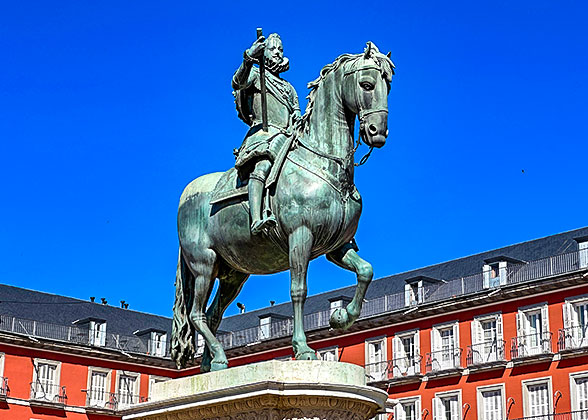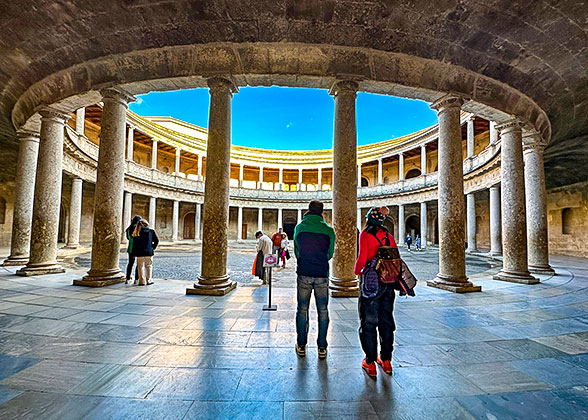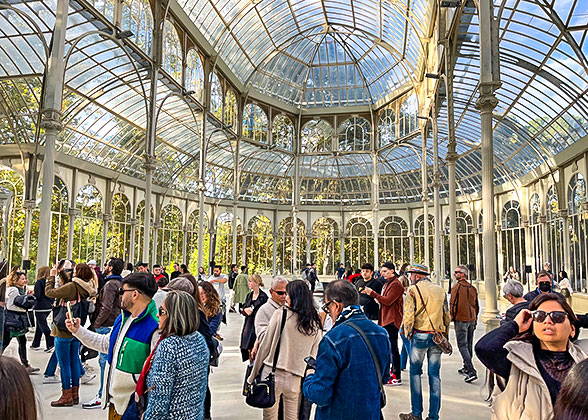Spain Weather

Plaza Mayor in Madrid
|
 Climatic Zones: Mediterranean Climate, Temperate Maritime Climate, Temperate Continental Climate, Temperate Plateau Mountain Climate
Climatic Zones: Mediterranean Climate, Temperate Maritime Climate, Temperate Continental Climate, Temperate Plateau Mountain Climate
 Average Temperature: 9-20°C (48.2°F-68°F)
Average Temperature: 9-20°C (48.2°F-68°F)
 Warmest Month: August: 17-30°C (62.6°F-86°F)
Warmest Month: August: 17-30°C (62.6°F-86°F)
 Coolest Month: January: 4-12°C (39.2°F-53.6°F)
Coolest Month: January: 4-12°C (39.2°F-53.6°F)
 What is the weather like in Spain?
What is the weather like in Spain?
Mediterranean climate prevails in southern and eastern Spain, with the highest temperature reaching over 40°C (104°F) in August. The winters are moderate and virtually frost-free. The two most enjoyable time periods of the year are March to May and September to November, when there is not much precipitation and moderate temperature. A temperate maritime climate with year-round favorable winds and precipitation is typical of northern and northwestern Spain. Here, the winters are chilly and the summers are cool. The climate of central Spain is temperate continental, where the summer is not extremely hot and winter is not too cold. Fall and spring are relatively longer. It is dry with little precipitation. Especially, the mountainous areas above 1,000m (3,280ft) in the central Spain have a plateau mountain climate. The temperature here is around 0°C (32°F) in winter and no more than 20°C (68°F) in summer. There is abundant precipitation, with snowfall at higher altitudes.
Best Time to Visit Spain: March to May and September to October
From March to May, everything in Spain is so exuberant under the mild and sunny weather. It is a great time to admire the fascinating natural scenery of the country. There are also a lot of interesting events you can join in, like Fallas and La Semana Santa procession!

Holy Week in Spain
|
Another excellent time to visit Spain is from September to October, when the weather gets cooler after the hot summer. Spain is full of colorful leaves in autumn and is also a season of harvest. It will provide you with a pleasant travel experience, whether you choose to hike under the autumn sun or enjoy the excitement of the grape harvest.
Monthly Weather of Spain - Temperature & Rainfall
Spain Seasons - Weather & Travel Tips
Spring: March to May

Weather: Mild and Warm

Mezquita Cathedral in Córdoba
|

Average temperature: 6-21°C (42.8 -69.8°F)

Travel season: Shoulder season

Clothes to wear: long-sleeve t-shirt, sweater, hoodie, trench coat, jeans, hiking shoes…

Best things to do:
1. Admire the apricot blossoms at Quinta de los Molinos in Madrid, the cherry blossoms at Valle del Jerte in Extremadura, and the peach blossoms at Aitona in Catalunya.
2. Join in the big events like the Fallas in Valencia, the Courtyards Festival in Córdoba, and La Semana Santa procession all over the country.
Travel tips: You will need a mask if you have a pollen allergy.
Summer: June to August

Weather: Hot and Dry

Old Town of Toledo
|

Average temperature: 14-29°C (57.2 -84.2°F)

Travel season: High season, especially the coastal areas

Clothes to Wear: t-shirt, short-sleeved shirt, dress, thin overcoat, shorts, light pants, sandals, sunglasses, parasols, sun hats…

Best things to do:
1. Have beach fun at Playa de Muro in Majorca, El Saler Beach in Valencia, and Platja d’en Bossa in Ibiza.
2. Escape the sweltering heat by traveling in northern Spain cities, such as Bilbao and San Sebastián.

Travel tips:
1. It is not a good time to visit Spain in summer, especially from middle July to late August. Locals close their restaurants and other stores to enjoy vacation on the seaside; some attractions in Madrid are veiled for renovation; city buses and metro run less frequently…
2. The big crowds, expensive accommodations and long waits are expected in summer along Spain’s coastal areas, so you’d better to make reservations in advance.
3. The outdoor sightseeing should be completed by 10 am, while from 14 to 16 pm, it is advisable to visiting indoor art galleries and museums.
Autumn: September to November

Weather: Pleasant and moderate

Flamenco of Spain
|

Average temperature: 7-26°C (44.6 -78.8°F)

Travel season: Shoulder season

Clothes to Wear: shirt, trench coat, hoodie, sweater, jeans, hiking shoes…

Best things to do:
1. Immerse yourself in the color of fall at the Valle Aran in the Pyrenees, Parque del Buen Retiro in Madrid and Parque Nacional de Ordesay Monte Perdido in Aragon.
2. Have a wine tour in Rioja San Mateo festival and Rueda Grape Harvest Festival.
Travel tips: It is recommended that you wear multiple layers of different thicknesses so that you can easily slip on and off when the weather changes.
Winter: December to February

Weather: Cold and Unpleasant

Average temperature: 4-14°C (39.2°F-57.2°F)

Travel season: Low season

Clothes to Wear: sweater, thick coat, down jacket, warm trousers, boots, gloves, hat…

Best things to do:
1. Go skiing in the Pyrenees resorts, such as Baqueira Beret, Boí Taüll and Espot Esquí.
2. Relax your body in hot springs, such as Balneario Cascante in Navarra, Balneario La Hermida in Cantabria and Balneario de Panticosa in Huesca.
If you are planning a trip to Spain in 2026, just join us!
Regional Weather of Spain
Eastern and Southern Spain

Major destinations: Barcelona, Valencia, Alicante, Seville, Londa, Malaga, Granada, Córdoba, Baleaies Islands

Weather review: Bordering the Mediterranean, the eastern and southern coasts of Spain enjoys typical Mediterranean climate. They are mild all year round. But it should be noted that the coastal areas have high humidity. The annual precipitation is 355-600 mm, and the average annual temperature is 19℃ (66.2℉).

Travel recommendations: The best time to visit eastern and southern Spain is Apr-Jun and Sep-Oct because of the moderate temperature and ideal sea temperature. The beaches here are popular all year round. On the golden beaches, you may experience the Mediterranean way of life, and playing volleyball with strangers is also an excellent option. But it is important to protect yourself from strong sun radiation.
Central Spain

Major destinations: Madrid, Segovia, Toledo, Valladolid

Weather review: It has 4 distinct seasons: hot summer, cold winter and mild spring and autumn. But because of its high altitude, its temperature is lower than that in other parts of the country with the same latitude. The average annual temperature is 18℃ (64.4℉). And the rainfall is not abundant with the annual precipitation ranging from 350mm to 460mm.

Travel recommendations: Some attractions in these cities are free of charge, so you’d better to make a reservation in advance and avoid the peak seasons of July and August, when it’s too hot for outdoor visits. As the capital city of Spain, Madrid has a wealth of historical sites. Particularly, you would admire the distinct aesthetic appeal of the magnificent Palacio Real de Madrid, which perfectly reflects the Rococo style. And after a 30-minute train ride, you can arrive at Toledo. It is dubbed as “the light of Spanish city” by Cervantes, the author of Don Quixote, and medieval cathedrals there will take you back to the golden age of Spain.
|

Museo Del Jamon
|
|

Plaza Mayor in Madrid
|
|
Northern and Western Spain

Major destinations: Bilbao, San Sebastián, Salamanca, Cáceres

Weather review: Dominated by temperate maritime climate, the weather in northern and western Spain is pleasant and mild in general, with an annual average temperature of 17°C (62.6°F). The annual precipitation of western Spain falls between 375 and 545 mm. And Northern Spain has more rainfall with the annual precipitation of 794mm to 1,042mm.
 Travel recommendations: The temperate northern and western Spain will not disappoint you if you are planning a trip during any month of the year. The Pyrenees is a great destination for skiing and hot spring bath in winter as well as a popular summer resort. Bilbao is well worth exploring for its famous Museo Guggenheim. You will admire the giant spider sculptures and dog shapes made of flowers. The other reason is delicious “PINTXO”. And you can feel strong academic atmosphere in the University of Salamanca. History buffs will have an amazing time exploring the architectures and historical landmarks in Cáceres, which fully reflect the intermingling of civilizations.
Travel recommendations: The temperate northern and western Spain will not disappoint you if you are planning a trip during any month of the year. The Pyrenees is a great destination for skiing and hot spring bath in winter as well as a popular summer resort. Bilbao is well worth exploring for its famous Museo Guggenheim. You will admire the giant spider sculptures and dog shapes made of flowers. The other reason is delicious “PINTXO”. And you can feel strong academic atmosphere in the University of Salamanca. History buffs will have an amazing time exploring the architectures and historical landmarks in Cáceres, which fully reflect the intermingling of civilizations.
Canary Islands

Major destinations: Tenerife, Teide

Weather: It has a subtropical Mediterranean climate with warm weather and the four seasons are not very clear. The daily sunlight time reaches 9 to 10 hours. The annual precipitation is low, which is concentrated in November and December.

Travel recommendations: The Canary Islands, an autonomous region of Spain, are located in the Atlantic Ocean of northwest Africa and were formed by volcanic eruptions millions of years ago. With 4 of Spain’s 13 national parks, more than any other autonomous region, your natural adventure will be realized here. Tenerife is the largest of the islands and attracts many tourists because of its nightlife scene. And Teide, the third largest volcano in the world, is a famous attraction here. The highway here is very developed, three hours are enough to explore the whole island. Dishes with Canarian characteristics, such as salted baked potatoes, are not to be missed. The restaurants are often full at 11 pm in late night.
3-Day Weather Forecast of Major Destinations

 Climatic Zones: Mediterranean Climate, Temperate Maritime Climate, Temperate Continental Climate, Temperate Plateau Mountain Climate
Climatic Zones: Mediterranean Climate, Temperate Maritime Climate, Temperate Continental Climate, Temperate Plateau Mountain Climate
 Average Temperature: 9-20°C (48.2°F-68°F)
Average Temperature: 9-20°C (48.2°F-68°F)
 Warmest Month: August: 17-30°C (62.6°F-86°F)
Warmest Month: August: 17-30°C (62.6°F-86°F)
 Coolest Month: January: 4-12°C (39.2°F-53.6°F)
Coolest Month: January: 4-12°C (39.2°F-53.6°F)
 What is the weather like in Spain?
What is the weather like in Spain?





![]() Travel recommendations: The temperate northern and western Spain will not disappoint you if you are planning a trip during any month of the year. The Pyrenees is a great destination for skiing and hot spring bath in winter as well as a popular summer resort. Bilbao is well worth exploring for its famous Museo Guggenheim. You will admire the giant spider sculptures and dog shapes made of flowers. The other reason is delicious “PINTXO”. And you can feel strong academic atmosphere in the University of Salamanca. History buffs will have an amazing time exploring the architectures and historical landmarks in Cáceres, which fully reflect the intermingling of civilizations.
Travel recommendations: The temperate northern and western Spain will not disappoint you if you are planning a trip during any month of the year. The Pyrenees is a great destination for skiing and hot spring bath in winter as well as a popular summer resort. Bilbao is well worth exploring for its famous Museo Guggenheim. You will admire the giant spider sculptures and dog shapes made of flowers. The other reason is delicious “PINTXO”. And you can feel strong academic atmosphere in the University of Salamanca. History buffs will have an amazing time exploring the architectures and historical landmarks in Cáceres, which fully reflect the intermingling of civilizations.






